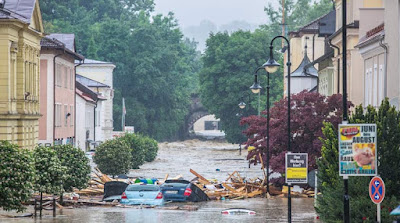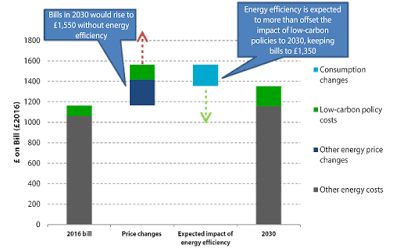With five million Europeans under threat of increased coastal flooding, policymakers – under pressure from persistent demand for low-cost development on the coast and inland – lack understanding of flood risk reduction and management, according to several new pieces of research.
This is a version of an article that appeared on 13 April in The Fifth Estate.
European homes are at risk from flooding from two directions: on the coast from sea-level rise and storm surges; and in floodplains and valleys from run-off during periods of extreme rainfall.
New analysis detailed in journal Earth’s Future shows that the five million Europeans currently under threat from once in a century floods (like those experienced in May last like) could face the same risk once a decade by mid-century and every year by the end of the century, as the climate continues to change.
The research is the first to take into account not only sea level rise due to warming temperatures, but also the impacts of climate change on tides, storm surge and waves when estimating future flood risk.
The authors used observations of the different factors plus climate models to estimate how each factor might change along the coastlines of Europe under different greenhouse gas emissions scenarios.
They found existing coastal protection structures were not up sufficient for protecting the five million homes most vulnerable under high-end warming scenarios.
Governments and building owners in these areas therefore face a stark choice: increase defences or move. Developers need to wake up to the risk of continuing to build in these areas and planners need to question whether approvals should be granted for development. Insurers will need help if they are to continue to provide cover. And property owners are likely to see the value of their properties drop.
Which areas will face the worst potential damage?
Seas are rising worldwide by about 3.2 millimetres a year, though rates vary from region to region because of local land rise and subsidence. If greenhouse gas emissions aren’t curbed, global seas could rise on average by 0.52 metres up to 0.98 metres by the end of the century, according to the most recent Intergovernmental Panel on Climate Change report.In Europe, the North Sea region is projected to face the highest sea level rise – nearly one metre under a high emission scenario by 2100 – followed by the Baltic Sea and Atlantic coasts of the UK and Ireland. Sea level rise is the main cause of the flood risk, but even more intensive extremes of weather along most of northern Europe will also generate significant local effects.
Least affected will be southern Europe, with the exception of a projected decrease along the Portuguese coast and the Gulf of Cadiz, offsetting sea level rise by 20-30 per cent.
This conclusion confirms the result of a separate report from 10 years ago that the regions most prone to a rise in flood frequencies are northern to northeastern Europe, while southern and southeastern Europe show significant increases in drought frequencies.
The cost will be in the many billions. Storms Desmond, Eva and Frank, which battered parts of Britain between early December 2015 and early January 2016, caused damage estimated to cost insurers £1.3 billion (AU$1.66b) in claims. Multiplying this throughout Europe under the above scenario will see potential costs in the many billions.
Thomas Wahl, who studies coastal flood risks at the University of Central Florida, calls the research “an important step in the right direction and, to date, the most comprehensive analysis of changes in coastal extreme sea levels under climate change for Europe”.
Flood resistant homes?
As I covered in February, the British Building Research Establishment has developed a flood-resilient home designed to be able to resist floodwaters up to a depth of 600mm. In addition, the home features a number of innovations aimed at reducing the damage and disruption caused should floodwaters actually penetrate into the interior of the house.But this type of development isn’t necessarily helpful. Another paper published recently in Science of The Total Environment found that while combined investment in property-level flood protection and sustainable urban drainage systems could certainly reduce surface water flood risk in times of extreme rainfall, the benefits could be outweighed by continued development in high-risk areas.
The researchers examined surface water flood risk in London, looking at how risk reduction could be achieved by homeowners and government, and the role of flood insurance and the new flood insurance pool, Flood Re, in the context of climate change.
Flood Re is a levy system in the UK agreed between the government and insurance companies to provide flood insurance coverage to homeowners who would otherwise be ineligible for it because of where they live.
Simulations showed that the scheme helps to provide affordable insurance, even under climate change but will face increasing financial pressure as the frequency of incidents increases.
The researchers say that if the intended transition to risk-based pricing is to take place then a determined and coordinated strategy will be needed to manage flood risk, something that isn’t currently happening.
This will involve a number of measures, including the provision of incentives for householders to make their homes flood-resilient, putting limits on new development in risky areas and installing neighbourhood-scale resilience infrastructure such as sustainable urban drainage systems.
The limits of land management
Other known broader scale methods of reducing the impact of extreme rainfall events include river restoration and tree planting. These aim to restore processes that have been affected by human activities such as farming, land management and house-building.However, more research shows that although such measures can play a valuable role in flood prevention, a lack of monitoring means their true potential remains unclear.
Experts led by Dr Simon Dadson of the University of Oxford compiled evidence on natural flood management, published this week in the Proceedings of the Royal Society.
It shows that measures to restore natural floodplains by “making room for the river” – for example by removing flood walls and other obstacles – do indeed reduce flood water levels.
But Dr Dadson cautions: “One of the main problems decision-makers face is that differences between catchments make it difficult to transfer evidence from one location to the other – and we don’t yet know whether the effects in small catchments can be extrapolated to larger ones”.
He adds: “What we’ve found is that when it comes to natural flood management, there are some interventions for which there is very strong evidence, but these tend to be in small-scale river catchments.”
For measures such as tree planting that aim to change the way rainfall runs off the land, the evidence of the impact on flooding is mixed.
“Natural flood management can help if implemented well in carefully chosen locations, and it can bring important benefits to landscapes and wildlife, but it’s not a silver bullet for the problem of flooding,” Dadson says.
He recommends that policymakers establish more systematic large-scale surveys and monitoring programs, and feed natural flood management into planning at the catchment scale.
With governments therefore lagging behind in their response to the increasing rate of risk rise to property from flooding, perhaps the best advice occupants can take is simply: move to a less risky location.
David Thorpe is the author of a number of books on energy, buildings and sustainability. See his website here.


